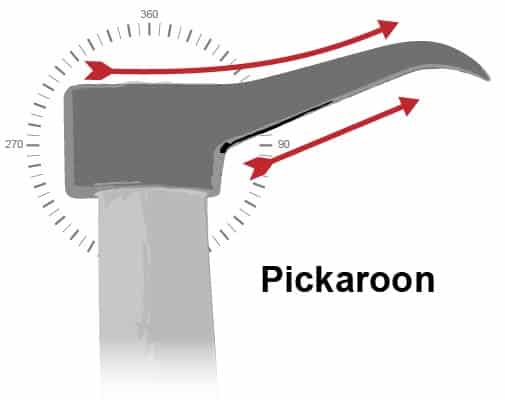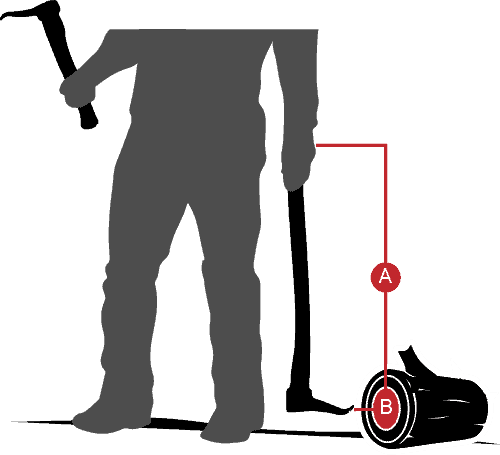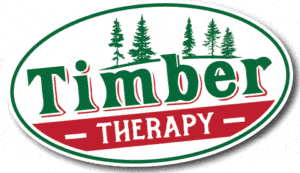A pickaroon is a hand tool used by loggers and other wood processing professionals to efficiently move wood products short distances such as when stacking firewood or repositioning bucked logs and rounds. Consisting of a compound angled spiked head mounted on a handle ranging in length between 18 and 48 inches, the pickaroon is a purpose-built tool that can greatly improve efficiency and reduce fatigue.
A Pickaroon is not a Hookaroon and vice versa.
In this modern age of logging and forestry, some of the collective wisdom of the past has been lost to manufacturing efficiencies, mechanization, and the resulting loss of collective experience. Prior to mechanized logging, there were numerous specialty tools designed to tackle every aspect of the logging process despite the labor and resources that were required to make them. Every tool had a specific purpose for which it was uniquely qualified. The Pickaroon is no exception.
At first glance, a pickaroon and hookaroon might appear to be made for the same task. They are after all both pointy hooks at the end of a stick. At a rudimentary level, you are correct, which explains why today both names are often seen as interchangeable and many manufacturers produce a “generalization” that often misses the mark. However, to those in the know, the pickaroon is a precision tool, while the hookaroon is not.
A true pickaroon has the following characteristics:
- Recurved/multi-angle spike
- Slim in stature
- Light to modest in weight
See the Pickaroon Vs. Hookaroon comparison in our article “What is a Hookaroon, Pickaroon?“
Benefits of Pickaroon’s Recurved/Multi-Angle Profile.
The pickaroon is a purpose-built tool that makes quick work of moving small logs and rounds with minimal effort.
The secret to a pickaroon’s effectiveness is the uniquely shaped head. The compound angles of the spike make engaging and disengaging logs, rounds, and other wood products as efficient as possible.

When used correctly, the user can pick up and drop material with just two small motions.
- Engage the wood with a slight strike, the blade will bite into the wood and hold it fast
- Release the wood with a quick pump of the handle toward the material.
Mechanically, the shape of the spike acts as a lever when it is under load. It will hold tight until the weight is removed, either by grounding the log or pushing the handle abruptly toward it. This is the main benefit of the Pickaroon over an axe or hookaroon when moving large amounts of material like split wood. Once mastered, the user will rarely need to touch the material with their hands or need to rock the blade back and forth to disengage it.
Selecting the Right Pickaroon
Having the right tool for the job at hand, even if it means having more than one will go a long way when used correctly. When choosing a pickaroon for a specific job there are two important factors to take into account.
- Handel Length
- Head Weight and Point Configuration
Choosing the Correct Handel Length
The handle length is a critical factor when selecting the right pickaroon for the job. A handle that is too long or too short will have a huge impact on its ergonomics and efficiency over time. After all, the main benefit of using a pickaroon is increased efficiency while reducing fatigue. The wrong-length handle will lessen both of these benefits.

Common pickaroon handle lengths are:
- 15 inches – Great for working close up such as stacking firewood
- 32 inches – Most common length for working with materials on the ground
- 36 inches – Allows for greater reach
- 48 inches
If the handle is too short, you will need to bend or reach when moving material that is on the ground. Additionally, if the material is in a truck bed or must be reached for, over time the additional movements required by the short handle will slow the job down and increase fatigue as well. The handle should be long enough to be swung into the material from a natural standing position into the center of the material and or facilitate reaching the material with minimal movement.
Conversely, if you are using the pickaroon to move material at waist height, such as when processing and stacking firewood, then a short-handled pickaroon is preferable to choking up on a long-handled one.
Head Weight & Point Selection
The weight of the pickaroon head often correlates to the materials being moved or processed. Hardwoods will require a heavier head or more aggressive point to achieve enough bite to secure the pickaroon into the material. When the correct combination of weight and point is found, the user can engage and disengage the material with small deliberate movements.
If the head is too light or dull the user will need to use more force to bite into the material. Although this is not optimal, it is preferable to a pickaroon head that is too heavy or aggressively tipped which will require more effort to manipulate and will over-penetrate the material causing the pickaroon to stick and require the user to pull it free.
Conclusion
If you process a ton of firewood, a pickaroon is a must-have. When used correctly, it will save your back and hands as well as speed up the process. Ideal for people who use a mechanical wood splitter, the pickaroon helps load wood onto the splitter’s deck as well as move and stack it once it is split. If you transport wood in a truck, a pickaroon is very helpful when loading and unloading a pickup bed. It eliminates a majority of the reaching and bending needed to get to the back of the truck bed.
If you process lots of knotty wood, or less than perfect rounds, you might consider using an axearoon. An axearron is a specialty picaroon that incorporated an small axe opposite the spike. The axe head allows for the removal of small brances or the reshaping of rounds as they are being placed into a mechanical wood spliter.
